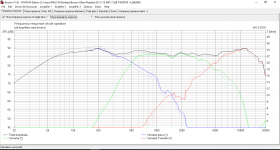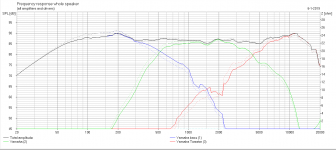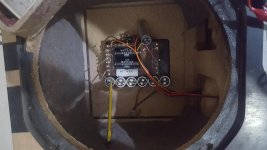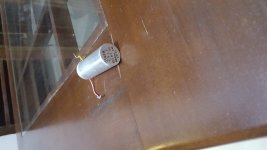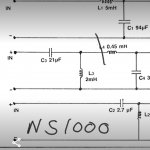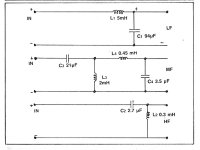In Boxsim I simulated the new X-over. This software can't simulate transformers and autoformers so I used three virtual amps with -7,5 dB for the mids and -4,5 dB for the highs to simulate the taps of the autoformer. I simulated the 7,8 uF cap for the mids with a 44 uF cap because of the impedance-factor of the autoformer. The Jabo autoformer has a very high inductance so this can be neglected here.
The 2x3,9 uF caps can be of high quality and are cheaper than the 21 uF of the original x-over so the use of an autoformer is not that expensive after all.
The new X-over is based on original L-pad settings somewhere between 'normal' and -3 for MF and HF.
The L-pads are now not dramatic but very subtle. -3 will now be -1dB and the effect is not the same. With the MF-L-pad at -3 the response is almost exactly the same as with the original X-over.
Note the loss in bass response from 60-200 Hz because of the L-C-R. This is a matter of taste. It will make your NS1000 woofer seem to go deeper.
The 2x3,9 uF caps can be of high quality and are cheaper than the 21 uF of the original x-over so the use of an autoformer is not that expensive after all.
The new X-over is based on original L-pad settings somewhere between 'normal' and -3 for MF and HF.
The L-pads are now not dramatic but very subtle. -3 will now be -1dB and the effect is not the same. With the MF-L-pad at -3 the response is almost exactly the same as with the original X-over.
Note the loss in bass response from 60-200 Hz because of the L-C-R. This is a matter of taste. It will make your NS1000 woofer seem to go deeper.
Attachments
hello to all is my second message in this forum, and I need some answers and help, within 2 and a half months I will have a Yamaha ns-1000m restored.
as I have been reading all the thread that decided that adding a magnet ring to woofer is won in power ??? In deep bass.
another I want to know is some decisive that by removing the yellow fiber inside the woofer earns in better sound ??? is heard more bass ???, then know if I removed the yellow fiber of the woofer.
the back of the woofer is with wood in sight if I add 4mm felt would be better ??, I also want to remove all the capacitors and put them or mark mundorf supreme, mundorf supreme evo oil, jantzen superior or jantzen silver.
another doubt is if in the filter I replaced the section of 6 capacitors 21uf, and I put a mundorf evo oil 22uf the sound would be affected and the sound would be worse ???.
or it is better to put 21uf is that I say it because in this way it implies having to put more capacitors to make the exact measurement of 21uf.
as I have been reading all the thread that decided that adding a magnet ring to woofer is won in power ??? In deep bass.
another I want to know is some decisive that by removing the yellow fiber inside the woofer earns in better sound ??? is heard more bass ???, then know if I removed the yellow fiber of the woofer.
the back of the woofer is with wood in sight if I add 4mm felt would be better ??, I also want to remove all the capacitors and put them or mark mundorf supreme, mundorf supreme evo oil, jantzen superior or jantzen silver.
another doubt is if in the filter I replaced the section of 6 capacitors 21uf, and I put a mundorf evo oil 22uf the sound would be affected and the sound would be worse ???.
or it is better to put 21uf is that I say it because in this way it implies having to put more capacitors to make the exact measurement of 21uf.
Last edited:
thanks for the gwmorgan answer, but I need people who have spoken here, how the filters have changed for new polypropylene capacitors, and what I have already explained.
I need please to the general of this forum that has expressed his knowledge with these yamaha ns-1000m, it is strange that all the people who have participated here have left and do not go out anymore.
please I need this help that I am asking for.
I need please to the general of this forum that has expressed his knowledge with these yamaha ns-1000m, it is strange that all the people who have participated here have left and do not go out anymore.
please I need this help that I am asking for.
thank you very much for not helping me in what I asked for please, I see that this forum is dead and nobody wants to enter is a pity, since I tell you since I come here new good registered since 2011 and I decide to write here.
it turns out that can not help me and it is not to hurry, or to tell me is that we have a life, take and I also have a life and at least answer if you ask for help.
and I've been waiting since May 27 to that you can answer to those who have these yamaha ns-1000m, since what I have been seeing are a few that you have spoken here and how you have made the changes in the filters and other things.
what is not understood that I have been waiting for that you give me that help that I asked you I've been waiting for you to answer 7 days is said soon.
so I think that this forum is dead and here nobody helps anyone, I really feel what I'm writing but that's what I feel, ahhh, thank you very much for the help that gwmorgan has given me.
it turns out that can not help me and it is not to hurry, or to tell me is that we have a life, take and I also have a life and at least answer if you ask for help.
and I've been waiting since May 27 to that you can answer to those who have these yamaha ns-1000m, since what I have been seeing are a few that you have spoken here and how you have made the changes in the filters and other things.
what is not understood that I have been waiting for that you give me that help that I asked you I've been waiting for you to answer 7 days is said soon.
so I think that this forum is dead and here nobody helps anyone, I really feel what I'm writing but that's what I feel, ahhh, thank you very much for the help that gwmorgan has given me.
Hi antoniopax,
This indeed is an old thread, already page 51.
I would replace the tweeter capacitor too, that one is very important. And if you could try the LCR across the tweeter that takes out the 2,...kHz resonance and will make the tweeter sound even smoother. You don't need to spend much money on these components.
You can take away the yellow glass fibre filling behind the woofer (use gloves!) and replace it with some Twaron, that will sound better. The felt you proposed is useless and won't do anything behind a woofer with 500 Hz. maximum.
There is a lot more that you can do but that will cost you serious money, like making the NS1000 active like TNT audio did. In stead of that I used autoformers and recalculated the entire crossover as an alternative to making them active. Mine now sound like actives: they can be played really loud without any edge or harsh sound.
Good luck with the Yamaha's. Even today there isn't much better to find in terms of transparency. Maybe the ATC SM50?
This indeed is an old thread, already page 51.
I would replace the tweeter capacitor too, that one is very important. And if you could try the LCR across the tweeter that takes out the 2,...kHz resonance and will make the tweeter sound even smoother. You don't need to spend much money on these components.
You can take away the yellow glass fibre filling behind the woofer (use gloves!) and replace it with some Twaron, that will sound better. The felt you proposed is useless and won't do anything behind a woofer with 500 Hz. maximum.
There is a lot more that you can do but that will cost you serious money, like making the NS1000 active like TNT audio did. In stead of that I used autoformers and recalculated the entire crossover as an alternative to making them active. Mine now sound like actives: they can be played really loud without any edge or harsh sound.
Good luck with the Yamaha's. Even today there isn't much better to find in terms of transparency. Maybe the ATC SM50?
another advance more and is the filter already placed mundorf supreme evo oil condensers, plus supreme silver oil and more white mcap, are already glued and welded together, and lack of welding to the metal strip but solder driver cables I already have yamaha speakers ns-1000m at home, the money that has cost all these capacitors is very high 510 euros, no one and I say nobody has this grade of high quality placed in their filters, only I am the only one that has placed so much level in these filters for these yahama ns-1000m, I will show more progress.


2019-07-16_10-30-03 | Simon Clarke | Flickr
Plenty of people have spent lots of money on caps and custom coils for their ns1000m builds. Trols used boutique jantzen caps, the pair on the link above use mundorf supreme, clarity caps, custom coils and resistors. I know of a pair rebuilt with £3000 worth of Delund caps.
The ones above are semi active with a 1200watt class d amp and PEQ on the bass and new xo filter parts. Then the xo is caused outside the cabs and they are as 2 + 1 way.
The ns1000 is a bit of a classic, many people dont mess with them. Some people dont think a £10 film cap sounds different to a £100 pound film cap. Some people would rather rebuild with new filters that deal with the bass to mid phase aberrations rather than spend it on caps. My own ns1000 use RAAL ribbon tweeters Instead of the Yamaha ones and have all the caps replaced with clarity film caps.
Plenty of people have spent lots of money on caps and custom coils for their ns1000m builds. Trols used boutique jantzen caps, the pair on the link above use mundorf supreme, clarity caps, custom coils and resistors. I know of a pair rebuilt with £3000 worth of Delund caps.
The ones above are semi active with a 1200watt class d amp and PEQ on the bass and new xo filter parts. Then the xo is caused outside the cabs and they are as 2 + 1 way.
The ns1000 is a bit of a classic, many people dont mess with them. Some people dont think a £10 film cap sounds different to a £100 pound film cap. Some people would rather rebuild with new filters that deal with the bass to mid phase aberrations rather than spend it on caps. My own ns1000 use RAAL ribbon tweeters Instead of the Yamaha ones and have all the caps replaced with clarity film caps.
I was surpriced to read in some of the past posts that some inductors have drifted.
Never have come across that.
Also some caps have drifted up!
When such things of un usual happen to me I check the meter with some standered values
And veryfy that the meter is up to speck.
Most of the time the meter was the culprit
Biggest culprit in speaker crossovers were bad solder joints.
Always tin the leads seperately before soldering.
Use a good solder, iron with enough wattage and a good flux.
Do not over heat.
Good solder joints would look like beads and not like dry solder lumps.
These old crossovers improve when all parts are removed, leads and wire ends sand papered,
Re tined, and freshly soldered.
Once soldered, jently pull the wires and leads carefully to make certain the joints hold well to vibration.
Oxidation, and failure of electolytics is the cause of bad performance with these equipment
Which have served us for a very long time.
By pass surgery can give back life.
Never have come across that.
Also some caps have drifted up!
When such things of un usual happen to me I check the meter with some standered values
And veryfy that the meter is up to speck.
Most of the time the meter was the culprit
Biggest culprit in speaker crossovers were bad solder joints.
Always tin the leads seperately before soldering.
Use a good solder, iron with enough wattage and a good flux.
Do not over heat.
Good solder joints would look like beads and not like dry solder lumps.
These old crossovers improve when all parts are removed, leads and wire ends sand papered,
Re tined, and freshly soldered.
Once soldered, jently pull the wires and leads carefully to make certain the joints hold well to vibration.
Oxidation, and failure of electolytics is the cause of bad performance with these equipment
Which have served us for a very long time.
By pass surgery can give back life.
I did a very extensive rebuild of my NS-1000s - all crossover components replaced, added bracing to cabinets, refinished, new stands etc. The full thread is here:
The giant 'Refurbishing my Yamaha NS-1000M's' thread - AudioFlat
The giant 'Refurbishing my Yamaha NS-1000M's' thread - AudioFlat
Here is a picture of how all the condensers are located in the original filter and it is excellent, if I got to know before they could fit in this way but good is already mounted and to enjoy them.
ahh good as now the media area is set because there has been a great improvement in the media speaker, it is even clearer with a very good tone in the voice y tweeter also much improved.
and the bass sounds a little better thanks to the improvement of those capacitors, but here I can say that it is just a little bit not a big improvement, if before it was good now it is even better the improvement in the media and in the tweeter hehe.

ahh good as now the media area is set because there has been a great improvement in the media speaker, it is even clearer with a very good tone in the voice y tweeter also much improved.
and the bass sounds a little better thanks to the improvement of those capacitors, but here I can say that it is just a little bit not a big improvement, if before it was good now it is even better the improvement in the media and in the tweeter hehe.

I don't have time to read this whole thread, but I think it may be worth mentioning that, regarding bass, I would think twice about removing Yamaha's idea of the correct amount and type of damping material—that will alter the intended bass tuning, part of which includes correct room positioning.
Much better to do what many seem not to take into account, and that is positioning the speakers against, not just near, the wall behind them. This was the design intention, is specified in the owners manual, and what was usual practice back in the day when these were designed. It was not usual in those days to position speakers on tall stands out into the room.
The slow roll-off in the NS_1000's bass response is nicely compensated by the resulting reinforcement.
I believe that bass quality of the NS-1000 is one of the design strengths, especially when positioned this way.
Much better to do what many seem not to take into account, and that is positioning the speakers against, not just near, the wall behind them. This was the design intention, is specified in the owners manual, and what was usual practice back in the day when these were designed. It was not usual in those days to position speakers on tall stands out into the room.
The slow roll-off in the NS_1000's bass response is nicely compensated by the resulting reinforcement.
I believe that bass quality of the NS-1000 is one of the design strengths, especially when positioned this way.
Pioneer saves the Yamaha NS1000M
I listen to music loud.
Recently when playing female vocals I noticed the mids distorting in one side.
When playing loud the Pioneer AX4 amplifier tripped.(this should happen only when the amplifier is overloaded)
Disconnected the NS1000 from the amp and measured the resistance with an analog meter. It read 2ohms, which is way too low for the 8ohm speaker. The other side measured 8ohms.
Removed the woofer and disconnected one terminal from the Xover.
Measured again the resistance at the speaker terminals. Still 2ohms.
Disconnected one leg each of the 21uf capacitor bank and the 3.5 uf single capacitor.
Measured and found that the 21uf bank of the original Nichicon (3.5uf X 6) was shorted
and reading 2ohms.
Replaced all Nichicon 3.5 uf electrolytic caps with mkp type foil capacitors.
Fitted every thing back and tested.
The sound was super.
Now I can go very loud and the Pioneer AX4 amplifier does not trip.
The Pioneer saved my Yamaha beryllium dome mid range unit.
I listen to music loud.
Recently when playing female vocals I noticed the mids distorting in one side.
When playing loud the Pioneer AX4 amplifier tripped.(this should happen only when the amplifier is overloaded)
Disconnected the NS1000 from the amp and measured the resistance with an analog meter. It read 2ohms, which is way too low for the 8ohm speaker. The other side measured 8ohms.
Removed the woofer and disconnected one terminal from the Xover.
Measured again the resistance at the speaker terminals. Still 2ohms.
Disconnected one leg each of the 21uf capacitor bank and the 3.5 uf single capacitor.
Measured and found that the 21uf bank of the original Nichicon (3.5uf X 6) was shorted
and reading 2ohms.
Replaced all Nichicon 3.5 uf electrolytic caps with mkp type foil capacitors.
Fitted every thing back and tested.
The sound was super.
Now I can go very loud and the Pioneer AX4 amplifier does not trip.
The Pioneer saved my Yamaha beryllium dome mid range unit.
Attachments
I recapped the entire crossover network when first purchased and years ago...found the original capacitors to be out of spec./high esr. The coils/inductors were also not within spec. I recall having to remove windings in order to bring the coils to spec or just replace them. The sound was improved but not amazing at first. Took a long time to break in. they do sound fantastic now. The hardest part was centering the magnet on the midrange; which involved a procedure that was very difficult. 

Mine, I had to center the magnets of both woofers because the bonding glue had given up
after 45 years and the center pole was sticking to one side holding the speaker coil stiff.
I had to phaste the magnets back on the two pole pieces with epoxy.
Used aluminium formers to center the magnets.
Done it myself without damaging the coils.
Any speaker kept without use for some time will need about 100 hours running in to break in.
This applys to some brand new speakers too. Stiff surrounds and spiders take time to
soften and give the best sound.
after 45 years and the center pole was sticking to one side holding the speaker coil stiff.
I had to phaste the magnets back on the two pole pieces with epoxy.
Used aluminium formers to center the magnets.
Done it myself without damaging the coils.
Any speaker kept without use for some time will need about 100 hours running in to break in.
This applys to some brand new speakers too. Stiff surrounds and spiders take time to
soften and give the best sound.
Mine, I had to center the magnets of both woofers because the bonding glue had given up
after 45 years and the center pole was sticking to one side holding the speaker coil stiff.
I had to phaste the magnets back on the two pole pieces with epoxy.
Used aluminium formers to center the magnets.
Done it myself without damaging the coils.
Any speaker kept without use for some time will need about 100 hours running in to break in.
This applys to some brand new speakers too. Stiff surrounds and spiders take time to
soften and give the best sound.
the mid spkr magnet is incredibly powerful, pinches the voice coil very tightly and is very difficult to get off the coil. I used a vice grip pliers, after heating up the glue on a cooking stove,to get it to budge. pieces of a credit card kept the magnet centered until it cooled. very difficult.
 :
:yes,they're pio caps. I've had too much trouble breaking in Russian pio caps, so I just use mundorf aluminum oil.

the inductors are very important to how the sound is reproduced...noticed immediate positive results with the bass inductor(after adjusting it)... boom, boom, boom!
the tweet and mid controls make a difference after spraying with deoxit.
i put an auto reset fuse relay on the tweet and mid...they're too expensive to repair/ replace. best spkrs for a grand, if the midrange is not hampered by the pinching magnet issue. they truly sound amazing after a bottle of vino
Last edited:
- Home
- Loudspeakers
- Multi-Way
- Yamaha NS1000 crossover Tweaks
